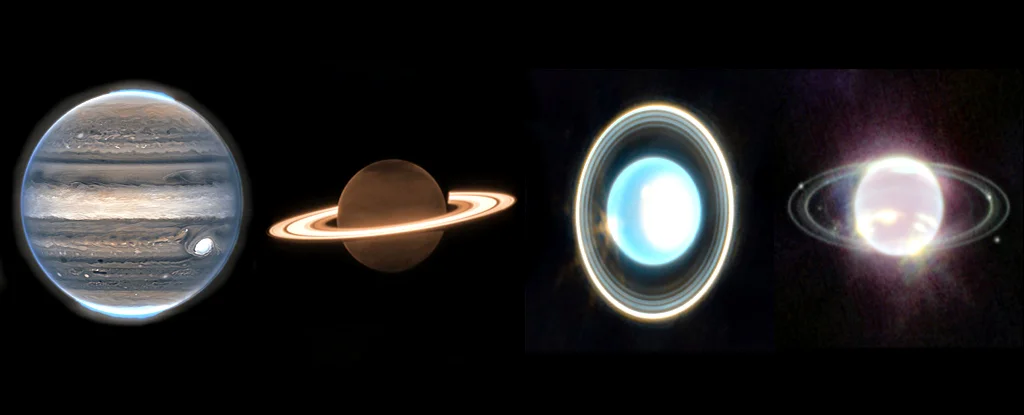JWST has finally captured all four giant planets of the solar system.
- July 3, 2023
- 0
The James Webb telescope has finally captured all four giant worlds in our solar system. JWST observations of the ringed planet taken on June 25, 2023 have been
The James Webb telescope has finally captured all four giant worlds in our solar system. JWST observations of the ringed planet taken on June 25, 2023 have been

The James Webb telescope has finally captured all four giant worlds in our solar system. JWST observations of the ringed planet taken on June 25, 2023 have been cleaned and processed, giving us a spectacular view of Saturn’s magnificent rings glowing gold in the dark. In contrast, Saturn’s disk in the new image is rather dark, lacking the characteristic cloud bands, and appears a relatively indistinct, dull brown.
This is because of the near and mid-infrared wavelengths at which JWST sees the Universe. These wavelengths of light are generally invisible to the naked human eye, but they can reveal a lot. For example, thermal radiation associated with heat is dominated by infrared waves. When trying to learn what’s going on inside a planet covered in thick, opaque clouds, studying its temperature is a valuable way to do so.
Some elements and chemical processes also emit infrared light. Seeing planets in the solar system at wavelengths outside the narrow range allowed by our vision can tell us a lot more about what’s going on with them.
As we saw last week when we looked at JWST’s raw images of Saturn, the observations included filters that dim the planet’s light, allowing light from the rings and moons to shine brightly. This is necessary so that the team led by planetary scientist Lee Fletcher of the University of Leicester in Great Britain can study Saturn’s rings and moons in more detail.
They hope to discover new ring structures and possibly even young moons orbiting the gas giant. The image above shows Saturn’s three moons, Dione, Enceladus, and Tethys, to the left of the planet. Although the planet’s disk is dim, it also provides information about the seasonal changes of Saturn.
The Northern Hemisphere is nearing the end of 7 years of summer, but the polar region is dark. It may be an aerosol process of unknown cause. Meanwhile, the atmosphere at the edges of the disk appears bright; this may be a result of methane fluorescence or trihydrogen glow, or both. Further analysis can tell us which ones.
Jupiter was the first giant planet to receive the JWST treatment in images released last August, and hey, these are fascinating. The impressive detail seen in the planet’s storm clouds and storms may not be entirely surprising, but we’ve also seen some rare features: persistent auroras that flicker at Jupiter’s poles, invisible at optical wavelengths, and Jupiter’s thin rings.
We also saw two of the planet’s smaller, lesser-known moons, Amalthea and Adrasthea, with faint patches of distant galaxies in the background.
“This single image sums up the science of our Jupiter System Program, which studies Jupiter’s dynamics and chemistry, its rings, and its satellite system,” said astronomer Thierry Fouche of the Paris Observatory in France, who led the observations.
Neptune observations came in the second half of September 2022. Neptune can be a bit overlooked because it is so far away; You’re probably used to seeing the footage of Voyager 2 passing by in 1989. JWST’s observations have given new insight into the ice giant’s graceful rings for the first time in over 30 years, and for the first time in infrared.
He also discovered seven of Neptune’s 14 known moons and bright spots in its atmosphere. Most is storm activity, but if you look closely you’ll see a bright band surrounding the planet’s equator. This has never been seen before and may be a sign of Neptune’s global atmospheric circulation, according to scientists.
Uranus is also quite far away, but it’s also a huge oddity. The planets are very similar to Neptune but have slightly different hues which is a bit of a mystery and Uranus is also turned sideways which is hard to explain. JWST observations released in April 2023 don’t solve these mysteries, but they did reveal 11 of 13 structures in Uranus’ incredible ring system and a startling atmospheric illumination above the planet’s polar cap.
JWST has a lot to say about the early universe; but it also brings space science closer to home. As the first year of operation draws to a close, we can’t help wondering what new wonders will unfold in the years to come.
Source: Port Altele
As an experienced journalist and author, Mary has been reporting on the latest news and trends for over 5 years. With a passion for uncovering the stories behind the headlines, Mary has earned a reputation as a trusted voice in the world of journalism. Her writing style is insightful, engaging and thought-provoking, as she takes a deep dive into the most pressing issues of our time.